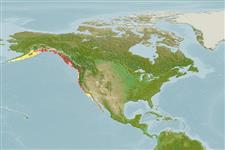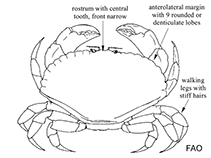Advertisement
Cancer productus Randall, 1840
Red rock crab| Native range | All suitable habitat | Point map | Year 2050 |

|
| This map was computer-generated and has not yet been reviewed. |
| Cancer productus AquaMaps Data sources: GBIF OBIS |
Загрузить свой Фото
Изображение на Google | No image available for this species;
drawing shows typical species in Cancridae.
Изображение на Google | No image available for this species;
drawing shows typical species in Cancridae.
United States (contiguous states) country information
Common names:
[No common name]
Occurrence: native
Salinity: marine
Abundance: | Ref:
Importance: | Ref:
Aquaculture: never/rarely | Ref:
Regulations: no regulations | Ref:
Uses: no uses
Comments: C: Refs. 78177, 78494, 93916, 865, 78677; R: Ref. 78177.
National Checklist:
Country Information: https://www.cia.gov/library/publications/resources/the-world-factbook/geos/us.html
National Fisheries Authority: http://www.nmfs.gov
Occurrences: Occurrences Point map
Main Ref: Jensen, G.C., 1995
National Database:
Occurrence: native
Salinity: marine
Abundance: | Ref:
Importance: | Ref:
Aquaculture: never/rarely | Ref:
Regulations: no regulations | Ref:
Uses: no uses
Comments: C: Refs. 78177, 78494, 93916, 865, 78677; R: Ref. 78177.
National Checklist:
Country Information: https://www.cia.gov/library/publications/resources/the-world-factbook/geos/us.html
National Fisheries Authority: http://www.nmfs.gov
Occurrences: Occurrences Point map
Main Ref: Jensen, G.C., 1995
National Database:
Common names from other countries
Классификация / Names народные названия | синонимы | Catalog of Fishes (gen., sp.) | ITIS | CoL | WoRMS
Environment: milieu / climate zone / depth range / distribution range экология
; пределы глубины 0 - 90 m (ссылка 78177). Subtropical, preferred 9°C (ссылка 107945); 61°N - 30°N, 168°W - 116°W (ссылка 78486)
Distribution страны | регионы FAO | Ecosystems | места находок | интродукции
Eastern Pacific: Nunivak and Kodiak Islands, Alaska to Isla San Martin, Baja California. Subtropical to temperate.
Length at first maturity / Size / Weight / Возраст
Maturity: Lm ? range ? - ? cm Max length : 20.0 cm CW самец/пол неопределен; (ссылка 78486)
Depth range is from intertidal to about 90 m. Max size from male specimen captured off Punta Banda, Baja California (Ref. 78177). Forages on shores protected from wave action. Juveniles and mating pairs occur in the intertidal zone only on nocturnal high tides (Ref. 78483). Buries itself in the substrate during periods of inactivity (Ref. 78491). Excavating predator (Ref. 78493).
Life cycle and mating behavior половая зрелость | размножение | нерест | Eggs | Fecundity | Larvae
Most species produce a single brood each winter but may reach up to two or three broods per year and the reproductive life span is about 4 years. The cumulative number of broods produced over the maximum life span is about 4 broods.
Основная ссылка
ссылки | координатор | соавторы
Jensen, G.C. 1995. (ссылка 78177)
Статус Красного Списка МСОП
(ссылка 130435: Version 2024-2)
Статус СИТЕС (ссылка 108899)
Not Evaluated
CMS (ссылка 116361)
Not Evaluated
Использование человеком
рыболовство: коммерческий
FAO - рыболовство: landings | FishSource | Sea Around Us
инструменты
дополнительная информация
ресурсы в Интернет
BHL | BOLD Systems | CISTI | DiscoverLife | FAO(рыболовство: ; publication : search) | GenBank (Геном, Нуклеотид) | GloBI | Gomexsi | Google Books | Google Scholar | Google | PubMed | Tree of Life | Wikipedia (Вперёд, поиск) | Zoological Record
Estimates based on models
Preferred temperature
(Ref. 115969): 8 - 12.1, mean 9.6 (based on 82 cells).




